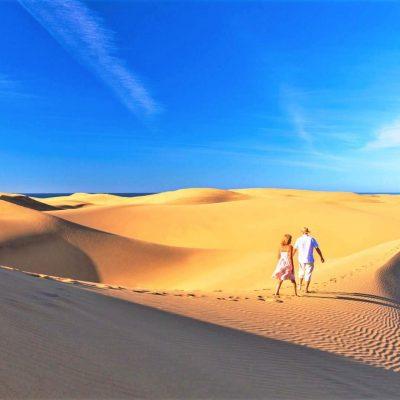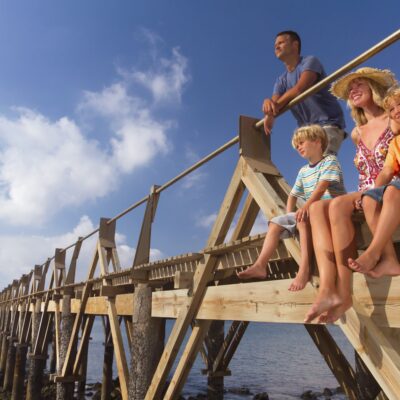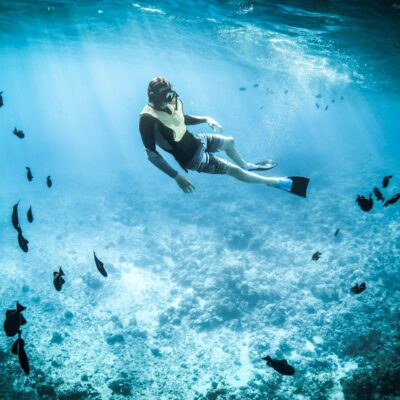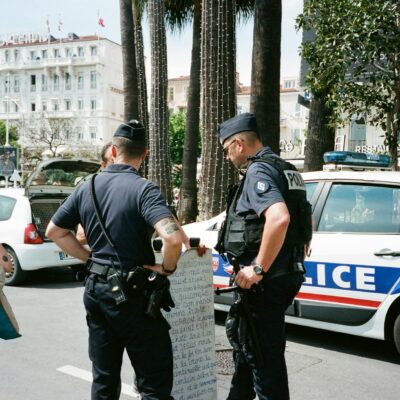Best Places to Snorkel in Tenerife: Top Spots, Tips & Safety Advice
Snorkelling in Tenerife is one of the most popular water sports on the island. In this guide you’ll find the best places in Tenerife for snorkelling, with practical tips about conditions, marine life and how to enjoy each spot safely.
Plan your next snorkelling adventure in Tenerife and enjoy a pleasant climate, excellent underwater visibility, abundant marine life and dramatic volcanic seascapes. The south and south-west coasts usually offer the calmest, safest waters with fewer strong waves than many other Atlantic destinations.
Quick safety notes before you snorkel in Tenerife
- Check conditions first: ask locals or lifeguards about currents, waves and entry points. Conditions can change quickly, especially in the north and at rocky spots.
- Respect marine life: enjoy turtles, rays and fish from a distance. Never chase, touch or feed them.
- Wear suitable footwear: many snorkelling spots in Tenerife are rocky and can be slippery.
- Use reef-safe sun protection: strong sun + long time in the water = easy sunburn.
- Stay visible: in areas with boats, a brightly coloured buoy or snorkel helps you be seen.
Disclaimer: Snorkelling involves natural risks. The content below does not replace professional safety guidance. Always evaluate the sea conditions, respect warning signs and follow lifeguard or local authority recommendations. Enter the water only if you feel confident and conditions are safe.
Why Tenerife is perfect for snorkelling
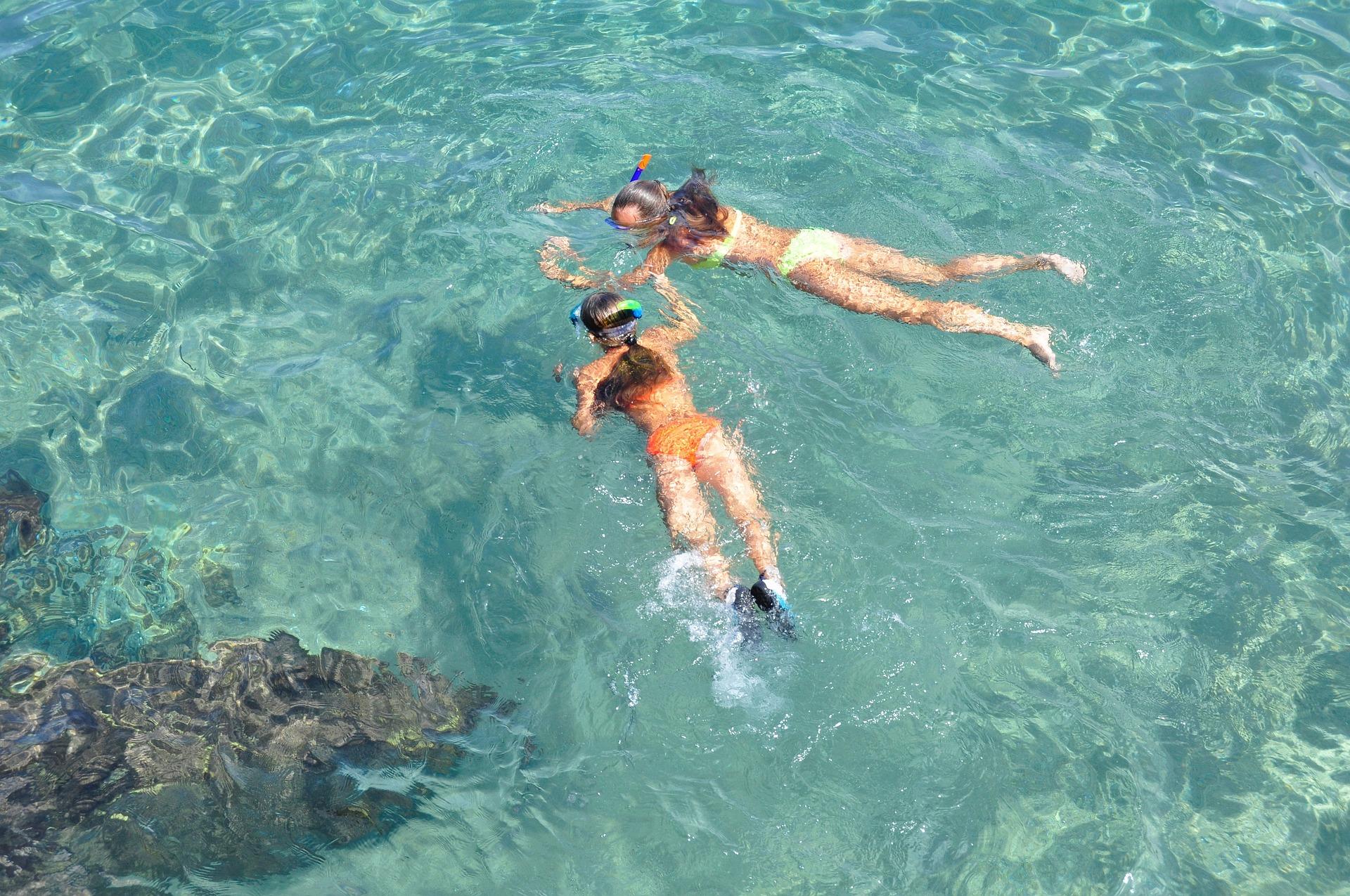
Snorkelling differs from scuba diving because you stay near the surface with mask, snorkel and fins. It’s an easy and fun activity for beginners and families, and can usually be practised by children from about 10 years old upwards (always under adult supervision).
Tenerife offers ideal snorkelling conditions all year round:
- Water temperature: usually between 18°C and 24°C throughout the year, so you can snorkel in winter and in summer.
- Visibility: clear, transparent water where you can often see down to 15–20 metres on calm days.
- Volcanic landscapes: caves, arches, crevices, lava tongues and steep cliffs that create spectacular underwater scenery.
- Marine life: coral areas, colourful tropical fish, rays, cuttlefish, octopus, starfish, schools of small fish and, with some luck, turtles and even dolphins passing by in the distance.
- Relatively sheltered areas: especially on the south and south-west coasts, where there is less swell than on many other Atlantic islands.
Where to get snorkelling equipment in Tenerife
The first requirement for snorkelling in Tenerife is to be able to swim confidently. If you can swim and feel comfortable in the sea, you only need basic equipment to explore underwater:
- Mask and snorkel: to see clearly and breathe while you float at the surface.
- Fins: to move more easily and save energy.
- Optional: a short wetsuit or rash vest for extra warmth and sun protection, and neoprene shoes for rocky entries.
You can buy equipment in specialised dive shops, sports shops and some supermarkets. Diving schools also offer snorkelling excursions with an instructor and all equipment included. Instructors usually speak English, Spanish and often other European languages.
On our website you will find different diving and snorkelling activities in Tenerife, as well as specialised diving courses and fun kayak trips that combine kayaking with snorkelling stops. Write to us by WhatsApp if you have any questions or want to book.
Best places to snorkel in Tenerife
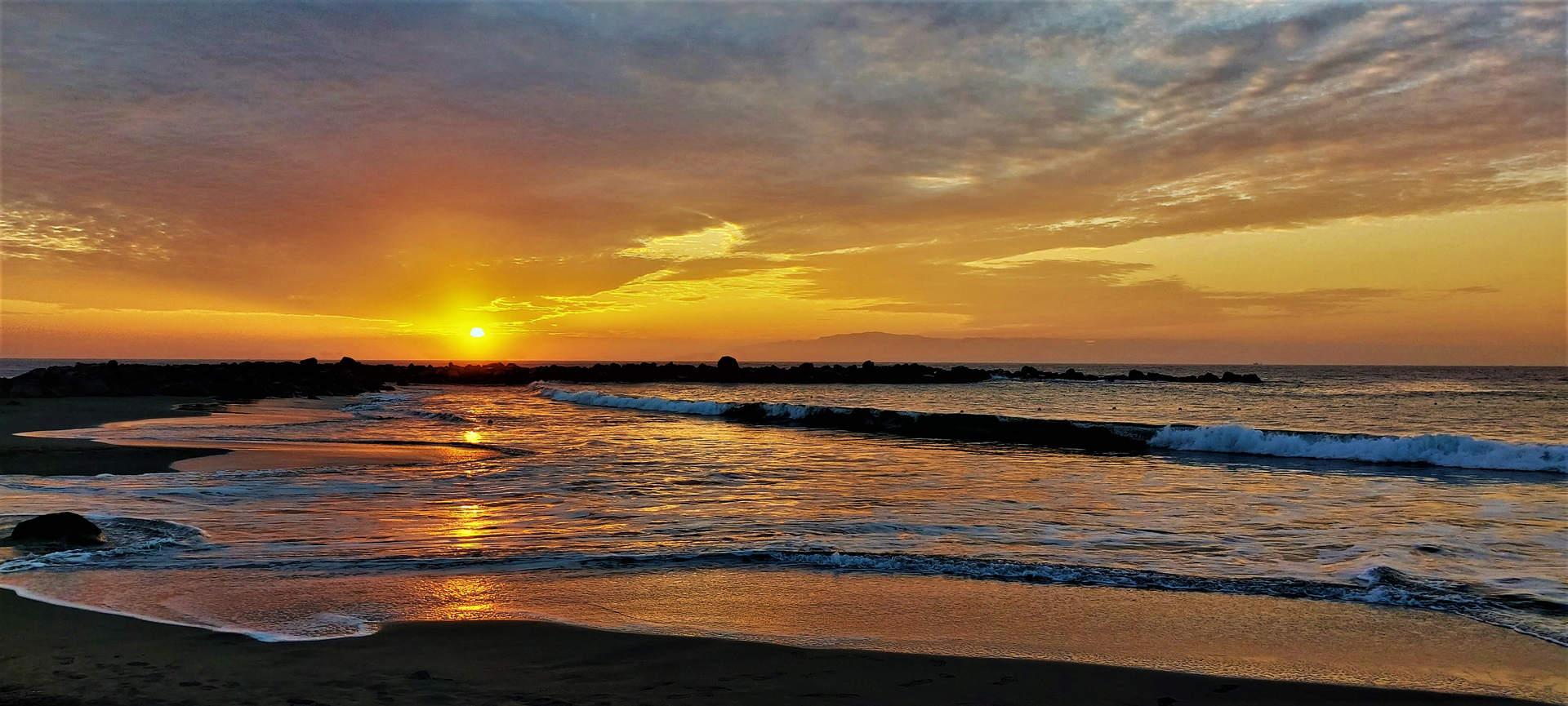
Below you’ll find some of the best snorkelling spots in Tenerife, based on local knowledge and our customers’ testimonials. Always check sea conditions before entering and adjust your choice of spot to your level and to the day’s conditions.
1. Abades – easy coral reef and sebadales
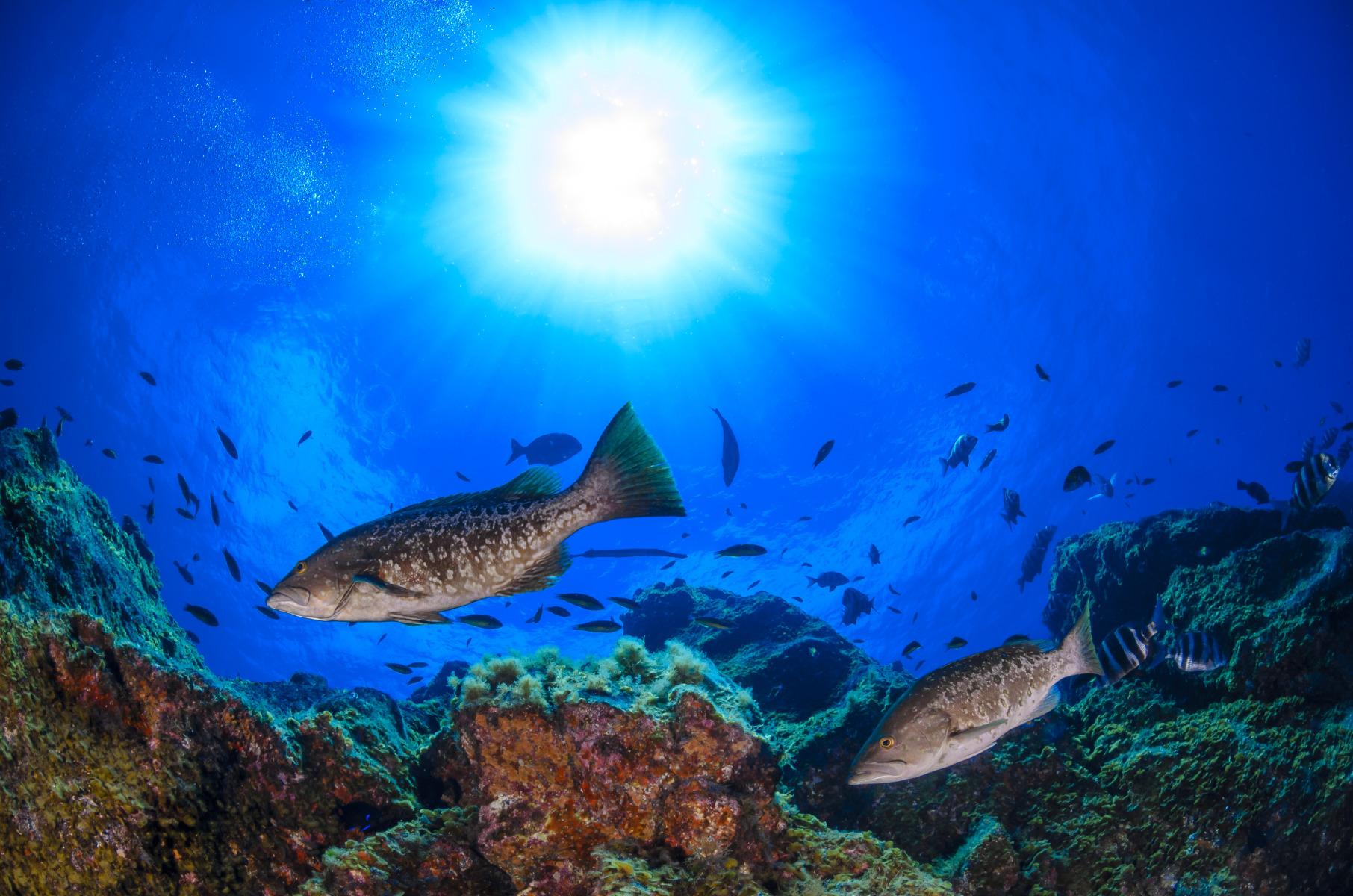
Abades is a small, quiet village close to El Médano on the east coast of Tenerife. It’s one of the island’s favourite places for snorkelling thanks to its natural coral reef very close to the shore.
- Access: easy entry from the sandy beach, with the reef accessible after only a 2-minute swim.
- Depth: mostly shallow, ideal for beginners and for getting used to snorkelling.
- What you can see: seagrass meadows (sebadales), octopus, trumpet fish, rays, schools of small fish and sometimes turtles.
- Nearby alternative: if you stay in El Médano and don’t want to travel, you can snorkel near the pier where you may see cuttlefish, moray eels and small octopus.
Best for: beginners, families and anyone looking for easy access and rich marine life without having to swim far.
2. Montaña Amarilla – lunar volcanic landscape
Montaña Amarilla (“Yellow Mountain”) is a very popular spot for snorkelling and swimming. Above the water you’ll see impressive yellow rock formations. Below the surface there are petrified dunes and volcanic structures that look like another planet.
- Access: entry is from rocks and platforms; water shoes are highly recommended.
- What you can see: crystal clear water, many fish and beautiful yellow sponges covering the rocks.
- Conditions: usually calm in summer, but always check waves and currents before entering.
Best for: confident swimmers who enjoy swimming in deeper, clear water with very scenic volcanic rock formations.
3. Los Abrigos – natural pools with volcanic walls
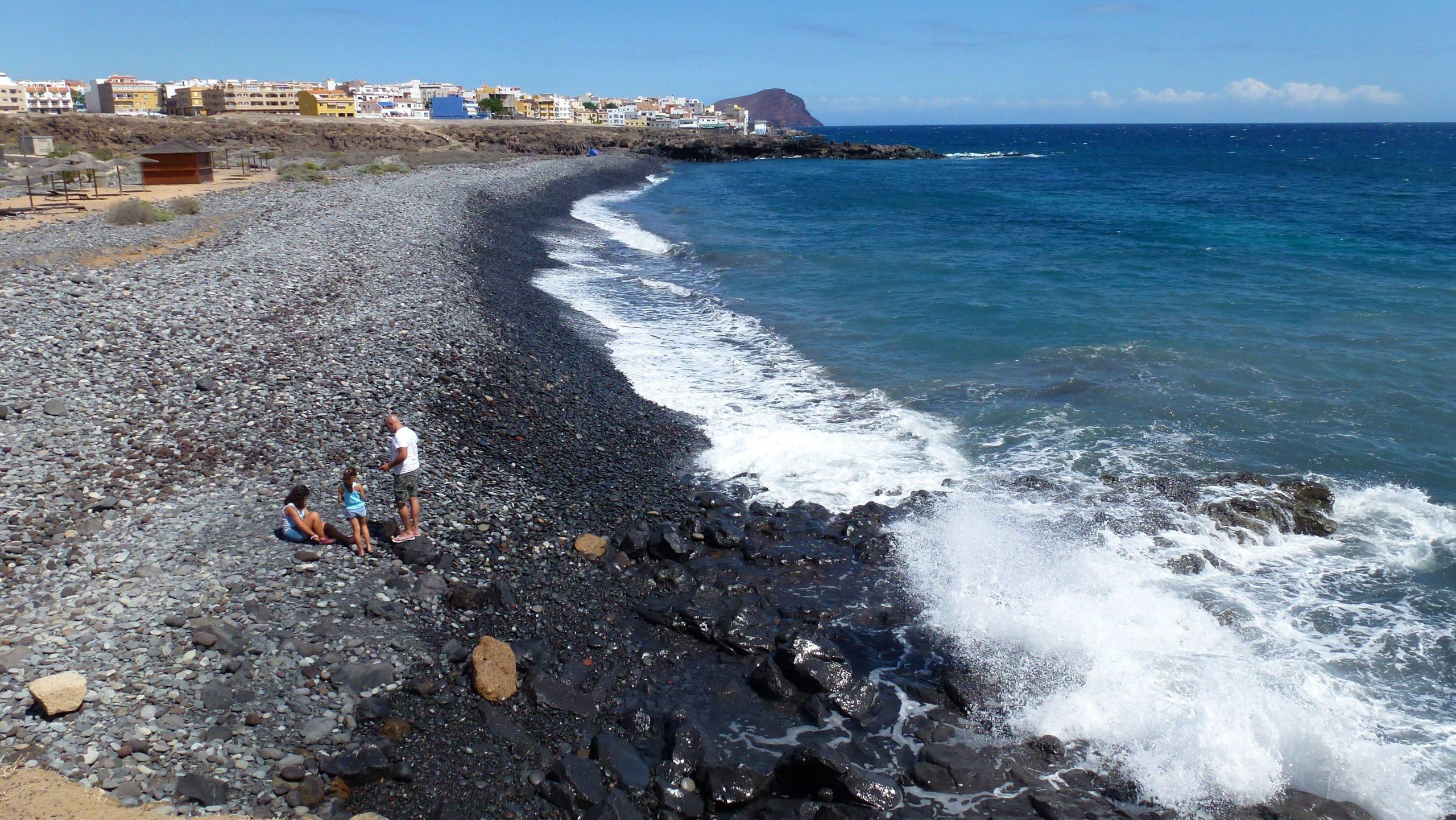
The natural pools of Los Abrigos were created by past volcanic activity and today offer calm areas protected from the swell. The dark lava walls and arches create an intimate and photogenic environment.
- What you can see: turtles, cuttlefish, octopus, crabs, starfish, rays and colourful fish hiding among the rocks.
- Water: usually clear, with good visibility on calm days.
- Tips: enter slowly, watch your step on the rocks and avoid jumping if you don’t know the depth.
Best for: snorkellers who like calm water and exploring corners, holes and rock formations full of life.
4. El Palmar Wall – turtles’ favourite highway
The wall of El Palmar drops down to about 25 metres deep and creates a very rich ecosystem for marine species. It is best explored with a guided excursion from a boat, rather than from the shore.
- Main attraction: a high probability of seeing turtles swimming freely in open water.
- Other life: trumpet fish, schools of fish and occasionally dolphins passing by in the distance.
- Important: turtles are wild animals. You must never touch, chase or surround them.
Best for: guided tours from boat, for swimmers who feel comfortable in open water and want to see turtles in their natural habitat in a respectful way.
5. Alcalá – rocks, natural pools and turtles

Alcalá is a rocky coastal area with several natural pools of calm water. It is known as one of the classic places in Tenerife where turtles have often been seen over the years.
- Access: the entry can be a little tricky because of the rocks, so water shoes are very useful.
- What you can see: turtles (if you are lucky), small fish, volcanic rock formations and, in the pools, calm, warm water perfect for relaxing.
- Tip: enter and exit slowly and always watch the waves before jumping.
Best for: experienced snorkellers and confident swimmers who are used to rocky entries and want a good chance of seeing turtles.
6. Los Cristianos Beach – easy access and lots of activity
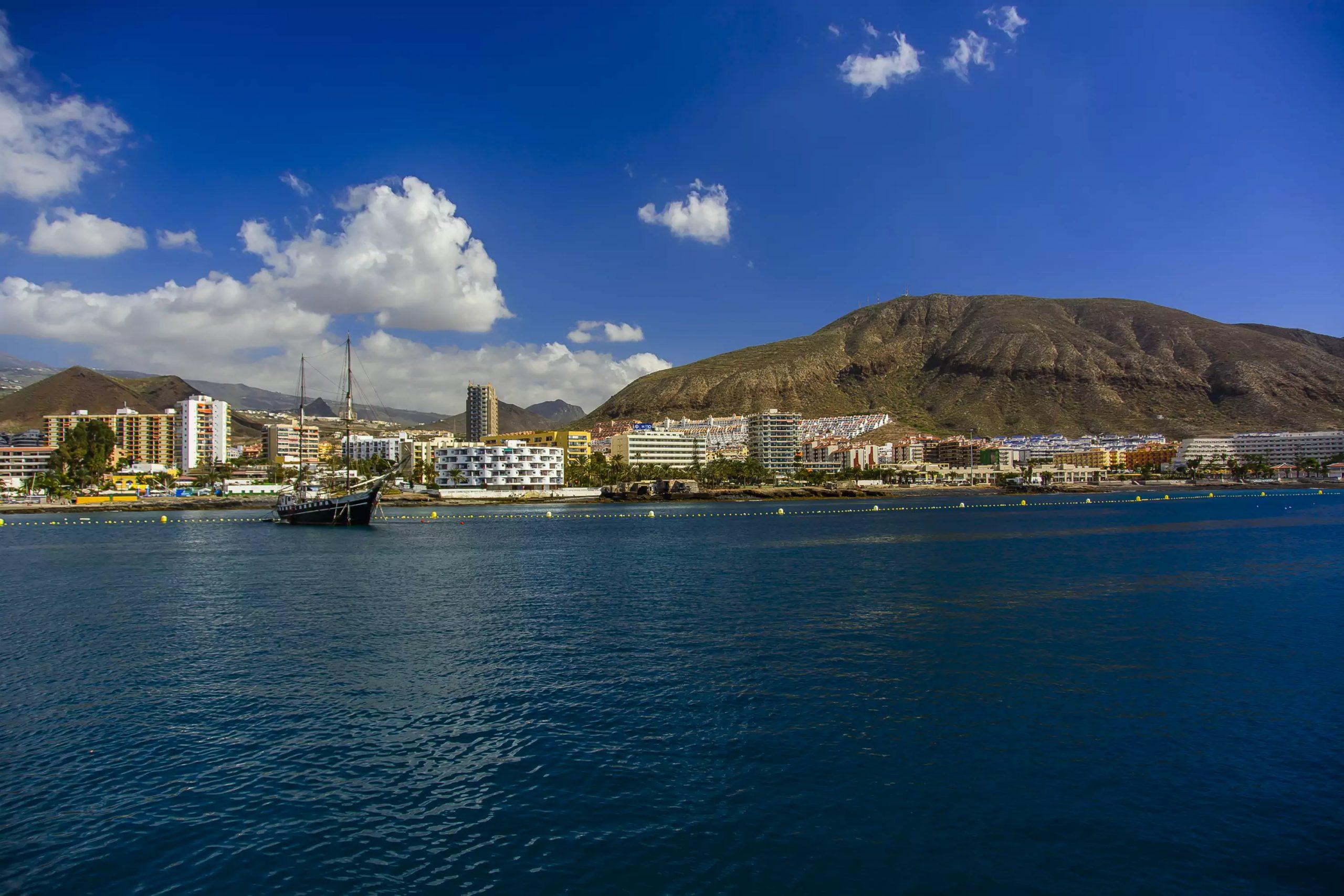
Los Cristianos is one of the most lively resorts in the south of Tenerife. Every day, hundreds of people enjoy water sports, boat trips and swimming in its bay.
- Access: sandy beach with very easy entry, perfect if you want to combine swimming and snorkelling.
- What you can see: volcanic seabed, small fish, occasional rays and sometimes turtles. Away from the shore, dolphins and whales can often be seen from boats.
- Extras: from Los Cristianos you can join kayak tours along the Guaza reserve with a high chance of observing dolphins and whales from the surface.
Best for: beginners, families and visitors who want to stay near the main tourist area with plenty of services, restaurants and activities.
7. Los Gigantes – snorkelling under the cliffs
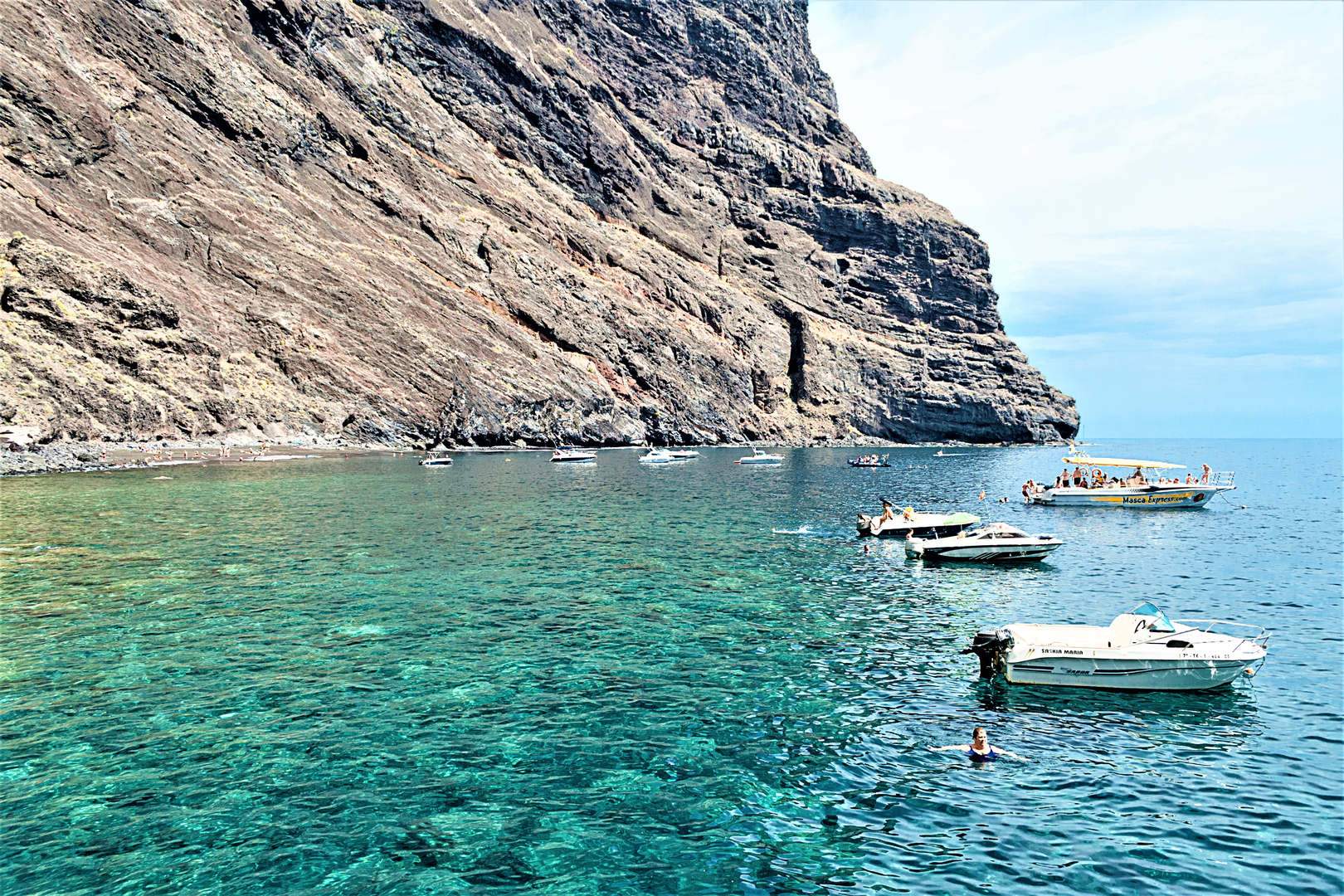
For many visitors, Los Gigantes (The Giants) is the best snorkelling spot in Tenerife. The huge cliffs rise vertically from the sea and create a spectacular natural amphitheatre.
- Access: usually by boat from Los Gigantes harbour or from other ports in the south and south-west.
- What you can see: clear water, vertical walls, schools of fish and an impressive view of the cliffs from the water level.
- Marine life: the area between Los Gigantes and Masca Bay is one of the favourite zones for Tenerife’s dolphins and whales, so you may see them on the way, from the boat.
Best for: boat excursions that combine sightseeing, swimming and snorkelling in a unique setting.
8. El Puertito Bay – snorkelling from boat and from shore
El Puertito is a small bay and one of the most visited places by our clients, as many of our boats stop here for swimming and snorkelling.
- Scenery: a very picturesque bay with green hills and small houses, ideal for relaxing.
- What you can see: colourful fish and, with a bit of luck, some of the green turtles that can still be found in the area.
- How to enjoy it: you can arrive on a boat trip and snorkel from the boat, or visit from land and explore the bay calmly from the shore.
Best for: visitors who book a boat trip and want to make the most of the swimming stop to explore the seabed.
9. Costa Adeje – easy access and many options

Costa Adeje is another very popular area for snorkelling in southern Tenerife. Its beaches and rocky points offer several spots where you can enter directly from the coast.
- Access: a mix of sandy and rocky beaches. Some spots are perfect for beginners, others for more experienced snorkellers.
- What you can see: lots of small fish, rocky seabeds and typical marine fauna of southern Tenerife.
- Extras: many guided snorkelling, diving and kayaking tours depart from this area.
Best for: those staying in Costa Adeje who want several snorkelling options close to their hotel, without long journeys.
10. Punta de Teno – wild snorkelling at the island’s edge
Punta de Teno, on the far north-west of Tenerife, is one of the most unspoilt corners of the island. Here you will find very clear, turquoise water and impressive rocky landscapes.
- Level: we recommend this area only for experienced swimmers. There are rocks, currents and sometimes waves.
- What you can see: abundant marine life, volcanic rock formations and beautiful views of the coast and the lighthouse.
- Safer area: the southern side of Punta de Teno usually has shallower, calmer waters, but you must always check the conditions before entering.
Best for: advanced snorkellers who want a wild, natural environment and are used to evaluating sea conditions and currents.
11. Charco del Viento – northern pools with clear water
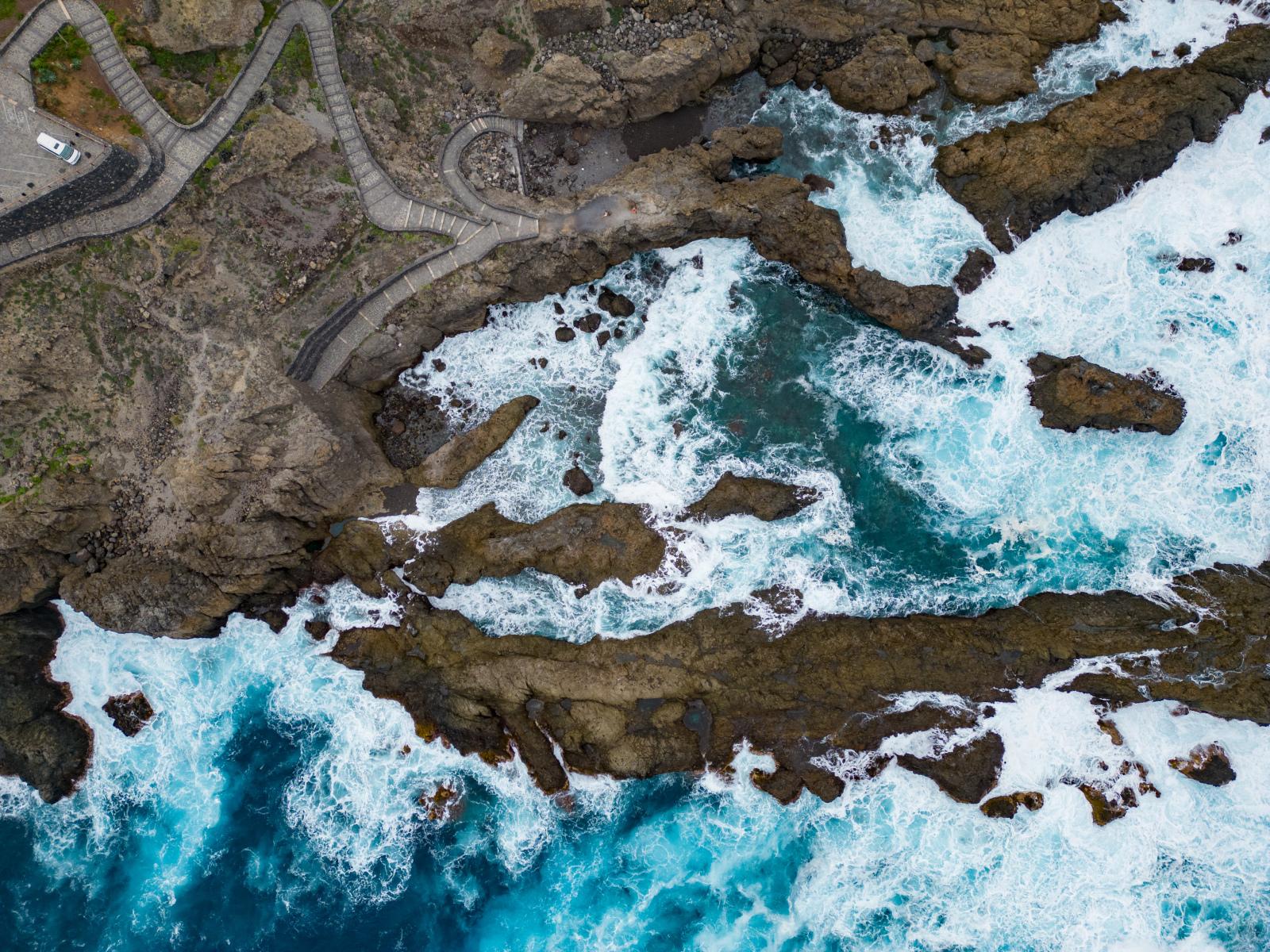
In the north of Tenerife you will also find beautiful places for snorkelling. One of the best known is Charco del Viento, a set of natural pools created by lava flows.
- Conditions: the north is generally rougher, but these pools offer more sheltered water when the sea is not too strong.
- What you can see: small fish, lava formations, and a unique view of the northern coast.
- Tip: avoid the pools if there is heavy swell, and always respect local warning signs.
Best for: visitors staying in the north who want to combine natural pools with some relaxed snorkelling on calm days.
Practical tips and safety for snorkelling in Tenerife
To finish, here is a more complete checklist so you can enjoy snorkelling in Tenerife safely and comfortably:
1. Choose the right spot for your level
- Beginners and families: prefer sheltered bays with easy entry, such as Abades, some areas of Costa Adeje, Los Cristianos and the calmer natural pools.
- More experienced snorkellers: can explore rockier and deeper areas, such as Montaña Amarilla, Alcalá, Punta de Teno or El Palmar Wall (always respecting safety rules).
2. Check conditions before entering
- Look at the waves, currents and wind before you enter the water.
- When in doubt, ask a lifeguard, a local or your excursion guide.
- Avoid entering in places where you see strong waves breaking on rocks or where there are clear signs of strong currents.
3. Protect yourself from the sun and cold
- Use high-protection, reef-friendly sunscreen and reapply often.
- Consider wearing a rash vest or light wetsuit if you plan to spend a long time in the water.
- A cap, sunglasses and a towel on the beach will help you rest between sessions without getting sunstroke.
4. Be careful with rocks and entries
- Many snorkelling beaches in Tenerife are rocky – water shoes can save your feet.
- Walk slowly and avoid running or jumping if you don’t know the depth or if rocks may be hidden below the surface.
- Be extra careful when leaving the water if waves are pushing you towards rocks.
5. Respect animals and the environment
- Never touch, chase or feed turtles, rays or any other sea creature.
- Do not stand on coral or seagrass, and avoid stirring up the sand too much.
- Take all your rubbish with you and, if you can, pick up any plastic you find.
6. Visibility, boats and safety equipment
- Visibility can change if there are waves, calima or plankton. If you see the water becoming very cloudy, stay close to the shore.
- In areas shared with boats, stay close to the coast and, if possible, use a bright snorkel or surface buoy so you are easy to see.
- If you are not a strong swimmer, use a buoyancy jacket or a foam noodle under your chest for extra safety.
Enjoy snorkelling in Tenerife with peace of mind
In conclusion, snorkelling in Tenerife is a fascinating adventure. The island offers transparent and generally safe waters for swimming, pleasant temperatures all year round and spectacular volcanic scenery above and below the surface.
If you’d like to discover the best snorkelling spots with a local guide, or combine your day with a boat trip or kayak excursion, you can write to us on WhatsApp. We’ll be happy to help you choose the most suitable activity for your level and for the time of year.
Follow these recommendations, choose the right beach each day and enjoy Tenerife’s marine life with respect and safety.




